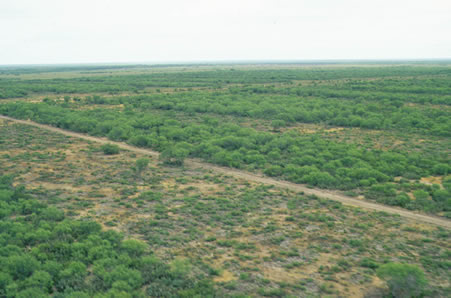South Texas Plains Habitat
Brush Management(Axe)

Brush Strip cleared by mechanical treatments — notice the diversity of plant structure
Most wildlife species are selective foragers, preferring to feed on a wide variety of plants rather than a few specific ones. Therefore, habitat improvement recommendations should emphasize the need for an even distribution of food supply from season to season, and the production of a wide variety of choice. Brush management or brush sculpturing allows solid stands of woody vegetation to be interspersed with cleared areas. Cleared strips or blocks produce desirable forb (weed) and browse production, while retaining an adequate mosaic of woody cover for escape, nesting, or protection from the elements. Properly utilized brush management practices can improve the menu of escape cover and food plants for both wildlife and livestock.
All brush management practices affect native populations in some way. Whether those impacts have a positive or negative affect is dependent on how the practice influences food supply and individual cover needs. When brush management techniques are used, it is important to remember these factors:
- The method of brush removal used should improve wildlife food supply and habitat -i.e. aeration vs. rootplowing.
- Plant Diversity and general health and vigor of the range should be increased.
- Removal of desirable plants species should be minimal.
- The amount and pattern of brush removal is critical. Extreme care should be taken to insure that too much wildlife cover is not destroyed — for example: drainages or sensitive habitats which support roost sites should always remain intact.
- Soil disturbance should not be applied to highly erodible sites. Any planned practices should consider topography and soil type.
- The program should be economically feasible and comply with the overall goals/objectives of the management program.
- Brush control programs should always consider prior mechanical treatments applied to the site.
- Brush management programs should plan for periodic maintenance of treated areas. Rarely, do any brush treatments completely eliminate brush, but rather they control it.
Today's wildlife managers use a combination of mechanical treatments with the ultimate goal of soil disturbance to increase water retention, and to reduce competition from undesirable woody vegetation by returning a plant community to its early successional growth stages. Resulting new growth exhibits increased nutritional levels, increased forage production, and increased forage palatability for most wildlife species. Available mechanical habitat manipulation tools include:
- Prescribed fire - Fire encourages improved nutrient cycling by fixing nitrogen in the soil from burn debris, thereby having a fertilization effect on the range. Fire encourages suppression of selected woody brush species and encourages the variety of herbaceous (forb or weed) growth depending on the timing and severity of the burn. See also: Prescribed Fire.
- Mechanical Brush Control - Rollerchopping/Aeration-Shallow soil disturbance (4-6 inches deep) and temporary removal of brush canopy to encourage palatable woody re-growth. Brush removal should be accomplished in strip or mosaic patterns (based on topography) to retain wildlife nesting/escape cover needs.